
2012.07.28
The 3rd Practical Application Course on Architectural Tours took place. All of the TOBIRA candidates (hereafter: TOBIKOs) submitted homework from the previous class titled “Making a Tour Course,” which each individual had prepared for the curator in charge, Ms. Kono. This time, Ms. Kono selected three ideas from the submitted course plans, and those three TOBIKOs actually presented their mock tours. While including the methods and compositions of tours they had learned so far, the history of TOBI, and characteristics of the building, they described the Museum in their own way.
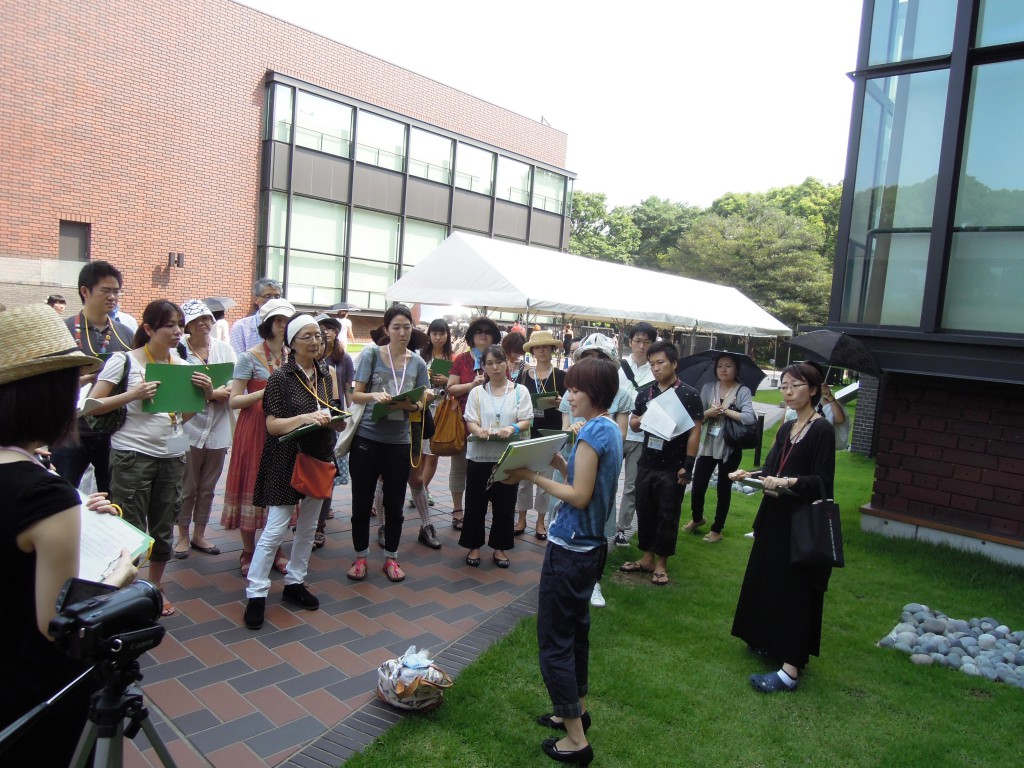
The tours were not just oral explanations; each tour had its own creative twists and there were some “aha” moments. For example, they utilized a sketch book to illustrate clearly and showed an actual broken piece of the outside wall from the renovation that ended the previous year.
The content of Course included TOBI’s signature exterior wall of red brick-like tiles, but also included the inside structure of the Museum as well.
Walking around the building while actually listening to the tour conductor’s stories allowed us to experience firsthand the ambiance of various locations in TOBI. There were things the participants themselves discovered and noticed as well.
After the mock tours, the participants all discussed the tours’ positive aspects and points of improvement. In the future, by utilizing the feedback from the mock tours they created themselves, they will develop courses and contents for Practical Application Architecture Tours.
I wonder what kinds of tours will be created. We can all look forward to them! (Iku Ōtani, TOBI Gateway Project Assistant)
2012.07.23
The Practical Application Course “School Monday (Art Viewing through Conversation)” has started. The class invited Ms. Norie Mitsuki, an art planner of the non-profit organization Art Resources Development Association, as an instructor. Attendees learned about “Savoring Art Together – Viewing” while mixing in a practical approach.
First, there was a lecture given by the curator in charge of “School Monday,” Ms. Inaniwa, regarding the overview of this Practical Application Course and the current status of art viewing education in elementary and junior high schools.
School Monday is a program for school teachers and children started by the Tokyo Metropolitan Art Museum (hereafter: TOBI) spurred by the museum’s renovation in April 2012. On days when the Museum is closed, we offer special art viewings, which are difficult to offer at schools due to the high volume of regular museum visitors. Also, this program provides support for children to become the main focus and be able to view art while freely forming opinions and thoughts, and then sharing them with others through discussion.
In recent years, curriculum guideline levels have been revised in elementary and junior high schools. In elementary school arts and crafts and junior high school art classes, collaboration with museums and other places for art viewing activities is indicated more clearly than before. Therefore, we from the museum side are thinking of creating better art viewing opportunities by collaborating with schools as well. One of the specific programs is an art viewing class through “conversation.” Art viewing through conversation consists of forming groups of approximately 10 students and holding discussions. We will need facilitators to assist the conversations depending on the number of students. With the aim of the TOBIRAs doing this facilitator role in the near future, currently TOBIRA candidates (herein: TOBIKO) will build up a practical application training curriculum of 14 classes this year.
Finally, the class moved on to this course’s practical contents. From the instructor Ms. Mitsuki, there was a brief summary of the VTS (Visual Thinking Strategy), which is the center of art viewing through conversation.
This VTS (Visual Thinking Strategy) is a method used to deepen the way we look at art. We start by looking at a piece closely – not relying on any art history knowledge – and encouraging people to think individually, asking “What is it?” as a method to extract the various opinions. It has an effect of cultivating the viewers’ “ability to observe,” “ability to think critically,” and “ability to communicate.” It was developed and spread by Philip Yenawine, former Director of Education at the Museum of Modern Art (MOMA) in New York, and cognitive psychologist Abigail Housen. The foundation the VTS style of art viewing though conversation was introduced to Japan in the ’90s. You might think that looking at an art piece while talking to someone is a natural thing we do every day, but the point of this VTS method is to create a “conversation” constructed by opinions as opposed to simply having a “conversation.”
After the summary explanation, participants actually experienced the VTS. They looked closely at the paintings and sculptures and other things projected on the screen and spoke freely about what they had noticed and discovered with the assistance of Ms. Mitsuki as our facilitator. Various opinions were exchanged about things such as motifs of the pieces drawn and impressions they got from them.
The third piece viewed was the “Rules of the Forest” by Taro Okamoto, which is displayed at a current TOBI exhibition called “The Story of Tokyo Metropolitan Museum.” After viewing the piece on a screen, the TOBIKOs moved to the exhibition room and viewed the actually viewed the original. It seems like there were many discoveries separate from the screen viewing, and various opinions came out during the opinion-sharing discussion afterwards.
The VTS was developed in America, but since the land is so vast, there are many people who are unable to go to museums. An art viewing method that was created in this sort of situation utilizes slides and projects pieces on screens as participants did this time. There are many things that can be done with slides, but they realized one can view art in much greater depth when in front of the actual object.
After experiencing VTS, there was a more detailed summarization, including specific methods.
he key to VTS is the art viewing facilitators. They ask questions of the viewers and create a nice flow of discussion to prompt the sharing of opinions. For example, when the viewers are children, there are times that their language is insufficient to convey what they want to say. Understanding the true meaning of statements and paraphrasing them enables opinion-sharing with others. Also, one of the most important things facilitators do is they “stay neutral.” The VTS focuses on the process of “learning to think” rather than on one “correct answer.” The facilitators are required to treat each opinion raised as a possibility, rather than deciding it to be a conclusion. It is important for the viewers to express their opinions, and develop them to think about the art piece individually. Moreover, there is no organizing or summarizing of opinions at the end of viewings. You might think that this would produce some vagueness, but by verbalizing one’s own opinions objectively under a facilitator’s lead, the visitors will recognize and be receptive to others’ opinions and have a desire to generate meaning from what one is seeing at the moment. Essentially, this develops within the viewer the intrinsic thoughts of wanting to “know” and “understand” on their own. Moreover, if these spontaneous thoughts get stronger, instead of throwing vague questions at others to seek answers, the “ability to continue thinking independently” will grow.
Art is a difficult field to verbalize, but listening to others’ thoughts and the satisfying feeling of verbalizing one’s own thoughts and sharing them will nurture abilities like continuing to think and learn as well as observe. Also, the ability to communicate will develop. At the end of the Course, the participants formed groups of 3 and shared issues such as the Course experience and their opinions.
After the 14th Course, the TOBIKOs will have actual discussions with children. There will probably be many students that have never been to a museum. I am already looking forward to the day that the TOBIRAs spend fulfilling time with children by playing an active role as facilitators for art viewing through discussions. (Iku Ōtani , TOBI Gateway Project Assistant)
2012.07.13
We welcomed Mr. Takahiro Sugiyama, an Associate Professor from Shiraume Gakuen University, who conducted the 2nd Access Program (Supporting Special Art Viewing for the Disabled) Practical Application Course with the theme “Teamwork and Accessibility.”
Attendees started by forming groups. However, group formation was done in the workshop format. Staff members put one of seven color stickers on the backs of the TOBIRA candidates (hereinforth: TOBIKO). The TOBIKOs did not know the color of the sticker on their back. Once stickers were placed on everyone’s back, they moved around so that the groups of the same color would be formed without saying anything, just by seeing each other’s reactions or by giving cues to the surrounding TOBIKOs through gesturing. When the groups were formed, each group lined up and sat down. As a result of this seemingly simple exercise, there was already an ambiance of rapport amongst one another by the time groups were formed. I was impressed that a little creative step introduced a foundation of teamwork.
Next, they played “quick line-up games” against the other groups. The first one was the “Order of Smallest Hands” – where the TOBIKOs re-lined up in this order. Everyone sat down together as soon as they finished lining up as a group. After that came “[Line Up in] Alphabetical Order by Name“and “[Line Up in] Order of Commute Time from Home to the Tokyo Metropolitan Art Museum.” In actuality, this exercise is a method for participants to introduce themselves naturally in a game-like manner.
Participants created a self-introduction card by filling out the answers from each game in the sheet that had been previously distributed (with each individual’s headshot). Experiencing the workshop method of teamwork creation was really fun, and these experiences may be useful for future collaboration events with elementary schools and other groups.
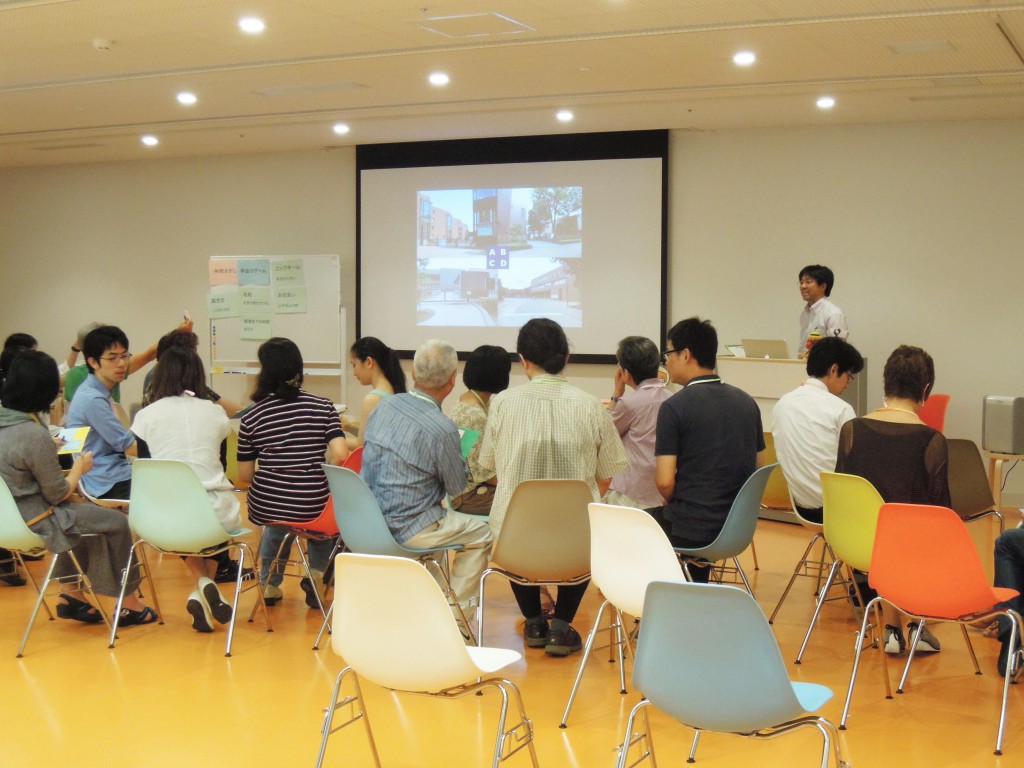
Then, TOBIKOs played the “Tokyo Metropolitan Museum Quiz.” We were given a question at once. “The four photos projected on the screen are all entrances to the Tokyo Metropolitan Museum. Put entrances A, B, C, and D in the order of North, East, Main, and Receiving entrances.” People raised their hands to answer as they solved the problem. The second question was quite challenging: “Put the photos of exhibition rooms without any exhibits in order from entrance to the exit.” The third question was to put the currently-exhibited paintings from the Royal Picture Gallery Mauritshuis in order from entrance to the exit. All of this information is a requirement for supporting the Special Art Viewing for the Disabled, but when you learn it using this method, your motivation for learning will increase. As for the results of these answers, the TOBIKOs, who are indeed familiar with the Tokyo Metropolitan Art Museum, answered them quickly and correctly, as expected.
For the latter half, Professor Sugiyama gave a lecture including specific precautions about implementing the “Special Art Viewing for the Disabled,” with “accessibility” as the key word.
This “accessibility” is a word indicating convenience; basically the same as terms like “barrier-free” or “universal design.” However, “barrier-free” and “universal design” have meanings associated with buildings. On the other hand, “accessibility” gives independence to those accessing. The Tokyo Metropolitan Art Museum is barrier-free, but not all conveniences are provided. Here, the most important thing is to have people watching attentively.
Therefore, the role of TOBIKOs in the next “Special Art Viewing for the Disabled” is to provide a safe and secure environment for all visitors, which is the most important thing. Beyond that, it was said that creativity is required for the visitors to have a more meaningful time. In addition, they were warned not to let our “support” become too “invasive” due to the feeling that one has to do something for the disabled visitors. It is especially important to not engage the name of the visitor’s disability, but give them support on the issue that is giving them difficulty in that situation.
I got to talk in advance with Professor Sugiyama a lot about the structure of the next Special Art Viewing for the Disabled. Unfortunately, there is a limit in the possible range of care when there is a large group of disabled people to support with only a small number of TOBIRA staff. Therefore, based on allowing the visitors to subjectively view works with assistance of caregivers, along with the TOBIKOs, I want to be creative by thinking “What we should do?” in order to provide a the best viewing experience. (Tatsuya Itō, TOBI Gateway Project Manager)
2012.07.05
The Access Program (Special Show Supporting Those with Disabilities) Practical Course has begun. The first Special Show (Mauritshuis Gallery exhibition) is scheduled for August 27th (Monday). This time, the instructor is the curator, Ms. Ōhashi, who is also the supervising curator of the Mauritshuis Gallery exhibition. At first, she explained such things as manners within the exhibition hall and an overview of the Access Program Practical Course that is starting now.
The Museum is closed today (Monday). The Practical Course proceeded in an empty exhibition hall. Initially, while confirming the route, Ms. Ohashi explained the works to us.
There is a long escalator in the exhibition hall. The building is normally packed and people usually have to wait 1-2 hours to enter. But it is deserted today.
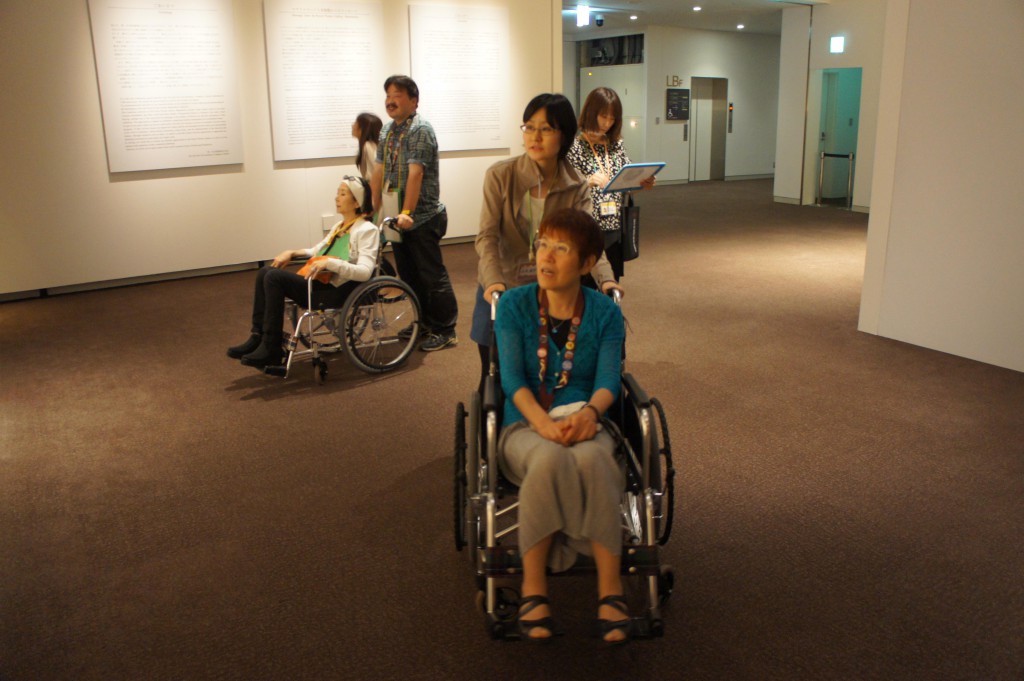
After confirming the route by walking the entire length once, we paired off and took in the works by wheelchair. We experienced for ourselves how we should navigate the exhibition space in a wheelchair and from what distance we could get a good view of the art work. When there are multiple wheelchairs in the exhibition hall, it feels smaller than usual. Since there will probably also be visually impaired visitors, it is important to understand the space.
Today we foresee a lot of visitors with disabilities coming to the Museum. The Access Program will grow through the combined results of many different efforts. (Project Manager: Tatsuya Itō)
2012.07.01
Following the Basic Workshop that took place on June 3rd, Mr. Oriza Hirata held a workshop on practical application. In addition to the TOBIRA candidates (TOBIKO), museum curators Ms. Inaniwa, Ms. Sasaki, and Ms. Tamura joined this time.
Scripts were distributed right away, and TOBIKO started acting. The scene is set on a train, where a male and a female were traveling, sitting facing each other in booth-like seats. While they are chatting casually, another female appears and asks to sit with them. They cheerfully allow the woman to sit, but their fake conversation and smiles continue. We can say that the three of them were having an awkward moment.
The TOBIKOs tried their best at acting while reading the script for the first time.
After acting out the script once through, Mr. Hirata explained the objective of the workshop. Once while doing this workshop for students in Drama club at a high school, one of the lines, “Are you on a trip?” surprisingly did not come out naturally. Mr. Hirata asked the high school students as to why their delivery of the line sounded so awkward. The answers that he got were “I have never struck up a conversation with a stranger on a train,” or “I cannot really grasp what it would be like, since I would never talk to a stranger like that.” Understandable. Mr. Hirata had an expectation of actors who could understand the subtle context of a scene featuring three people sitting together. However, it seems like high school students who had never experienced saying, “Are you on a trip?” could not understand the context of the lines.
Mr. Hirata explained that this situation is caused by the “context gap.” Essentially, this means that even if you understand the meaning of the words, there is a gap between the context of the words due to each individual’s living environments and cultures, yet the conversation continues on. However, these context gaps are quite difficult to notice in conversations. And Mr. Hirata pointed out that continuing a conversation without noticing this context gap is the biggest cause of communication failure in many cases. (No matter what kind of job you have, most complaints from clients can be attributed to this “context gap.”)
Incidentally, Mr. Hirata also held the same workshop for local college students in Australia. When he asked the students “Would you talk to someone that you just met for the first time in the train?” They responded, “It depends on their race and ethnicity.” When he offered the workshop in Ireland, everyone responded that they would talk to the strangers. In addition, when dealing with upper-class British people, initiating a conversation randomly without being introduced would be considered bad manners.
What was most interesting in Mr. Hirata’s explanation was that, in the world of theater, the playwrights and directors know the functions of these contexts inside and out. So it is possible to convey completely different meanings by cleverly altering the context of the performance, even if the lines are the same. Let’s suppose that a man who initiates conversation with “Are you on a trip?” was a British aristocrat, and then we’d be utilizing a different context; now the earlier picture of a man awkwardly talking to a stranger is quite different. It is possible to induce the audience to see different views. There is the previous example where the man was awkwardly talking completely changes into a “man who knows no manners” or a “scene where an attractive woman appears, making you want to forget about all manners and talk with her.” From these examples, it is clear that the “context” of a conversation is more important than the meaning of the words.
If that is the case, I felt that the ability to understand the “context” is necessary for any art communicator. According to Mr. Hirata, people typically represented as people who are disadvantaged in society, for example, children. They oftentimes talk based on context rather than meaning of words. For example, let’s say that there was a child who ran home in excitement and said, “I didn’t do my homework for today, but my teacher didn’t get mad at me!” At first glance, it sounds like the subject was about the child not doing his or her homework, so you would want to scold him/her. But actually, the child might have wanted to happily convey their appreciation of the teacher’s generosity, or how they really like the teacher.
When you think about this, it can be understood that the ability to understand the context of those who are disadvantaged and cannot speak logically (such as children) is even more so needed from those who support them (such as teachers and parents). In this regards, Mr. Hirata expressed hope that, rather than the ability to speak logically and critically, which was the previous emphasis of Japanese leadership education, future leaders gain the ability to read the context of those who are disadvantaged in society and understand the context of people who cannot logically express themselves.
This ability to understand context is expected to play large role in the medical field as well. Nowadays, modern medicine has become so advanced that the implications of treatment are more diversified than ever. It will not be possible to provide true treatment to patients unless you understand the patients’ needs – whether they want to live a mere second longer or spend the remaining time with their family. Also, understanding the context in daily nursing case is very important. When a patient complains about their chest and says, “My chest is in pain,” a good nurse will respond to them by calmly repeating what the patient has said – such as, “Your chest is in pain, right?” By repeating what they have said, it sends the signal that “I am here with you,” or, “I am focusing on you.” In this scenario, by understanding the patient’s context and letting them know that we have received their feelings and thoughts, we establish a basis of communication in the medical field.
However, these behaviors are not that complicated – it can be said that everyone already has the fundamental communication skills, and intrinsically, we use them in our daily lives. However, as Mr. Hirata points out, even if we each have high communication skills, it is easier for failure to occur in places where external factors may interfere with the context of their message, such as: in a hospital where people may panic easily; in the business world where there are numerous time constraints; and inside of a small research lab with a strong hierarchy. This can potentially lead to trouble in the organization. Therefore, individuals simply having the ability to understand context is insufficient. It is imperative to seek out the ideal forms of various communications by having multiple views that include external factors. For example, is a doctor’s seating arrangement conducive to talking easily with his patients? Or in a business environment, is the meeting room designed for a sense of openness?
Then, these ways of perceiving without directly connecting the cause and effect are called “complex systems.” The new academic field called “communication design” looks at problems in communications in complex systems. More precisely, there are many things that the TOBI Gateway Project will have to take into consideration, such as whether an environment suitable for good communication is set up or not.
Let’s go back to how the high school students could say naturally the line, “Are you on a trip?” Even if high school students who do not have much life experience are told to think about the line “Are you on a trip?” it would probably be impossible for them to understand the context hidden within the line. Instead of practicing the line “Are you on a trip?,” it is possible to teach them the context of the script by combining the high school students’ life experiences and the context surrounding the lines to make them think of the type of atmosphere where it would you must strike up a conversation. Oftentimes people say that a convincing performance is created when actors either become the characters or inhabit a different personality completely. Even professional actors and actresses expand their wings by embracing the parallels between their own life and the character they are portraying, and determining how the character would be if they were to strike up a conversation, even if the actor himself would not normally do that.
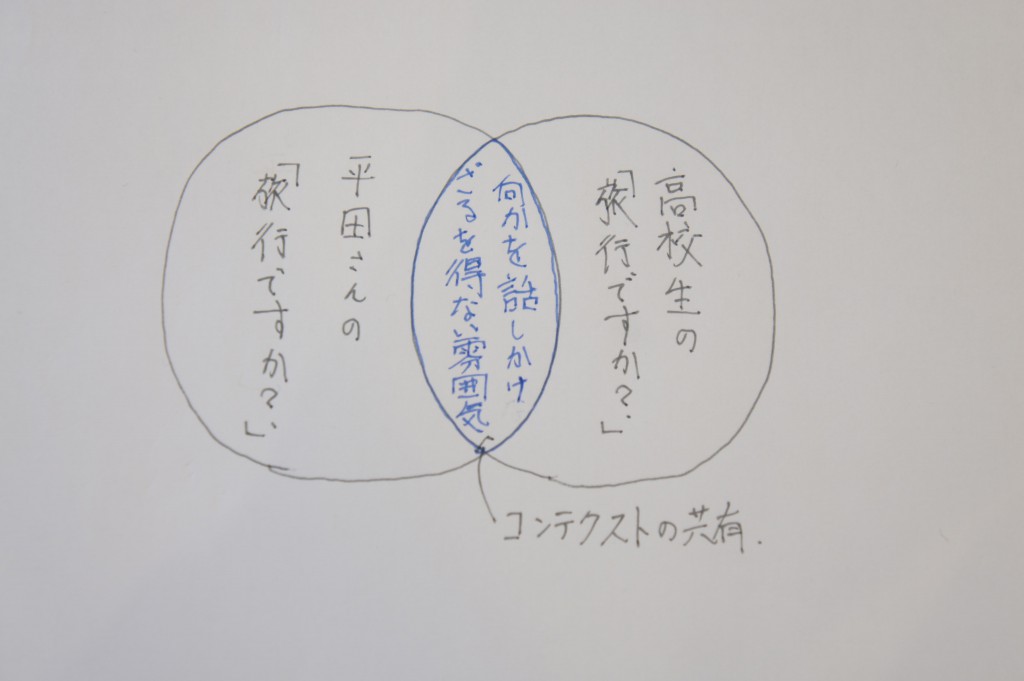
In order for us to understand the behaviors and values external (other people) to our own context (internal), you must first look for the shared parts of both parties’ contexts and expand the shared parts of the external (other people) context more and more. In recent years, this method has been gaining more attention in the education world as well. It is thought that role play has been advocated as a way of dealing with problems, especially bullying, going from a “sympathy-oriented education to an empathy-oriented education.”
With the meanings of “from sympathy to empathy” and “from uniformity to communality,” instead of simply sympathizing with bullied children, this is a method which attempts to resolve these issues by involving the bullied children’s feelings and finding commonalities (empathy) with as many children as possible while increasing the commonalities of the “emotional pain” even just a bit.
When you think about it, it feels like communication is achieved by seeking out the overlapping aspects between your own context and another person’s context. When there is a person we want to speak with, we seek out commonalities and try to expand them. The more things we have in common with the other person, the more likely we also enjoy the communication. This workshop touched on the importance of understanding the context of others, which is truly the starting point of communication.
The objectives of Mr. Hirata’s workshop were so intriguing that I almost forgot it was a workshop. Now let’s get back while keeping the original point in mind. The TOBIKO students were given an assignment to act out the line “Are you on a trip?” as naturally as possible. They had to find a way to create a situation where you would have to strike up a conversation and make the line “Are you on a trip?” flow more easily by adding 3-4 lines before it. This is a method where the actors themselves create context in the scene, so that they could personally understand it themselves. These 3-4 lines of the script are like the projection lines that you draw in geometry diagrams: you can use them to help you solve the problem and you can erase the projection lines later, if you can solve the problem well (or speak better).
Woman: (Makes a strange facial expression)
Man: “Ah, the dinosaur…”
Man: “It’s been here since we got here…” (Trying to show that it’s not theirs)
Woman: “….” (Awkward atmosphere)
Man: “Are you on a trip?”
It is quite a bit of a stretch, but it is an interesting example (laugh). At this point, the students were put into groups of three, and each group took turns performing their skit after discussing about how to make the line “Are you on a trip?” easier to say by adding 3-4 lines beforehand. They were given about 30 minutes to discuss. They worked very hard within the given amount of time, but the assignment was more difficult than it seemed. Once each of the lines was decided upon, each group performed their piece. It was quite entertaining with endless ideas (laughs) – one group asked “Would you like some red bean buns?” prior to the line “Are you on a trip?” Another group set the scene where suddenly the “Tower of the Sun” [a famous exhibition of the 1970 World Expo in Osaka] appears outside the window and after an exclamations of “Wow!”, someone asks, “Are you on a trip?”
After each group had finished their performance, Mr. Hirata’s made comments about each one. However, through understanding the context surrounding “Are you on a trip?”, we realized that there is a vast difference between reading the lines with feeling and performing the lines we struggled to come up with.
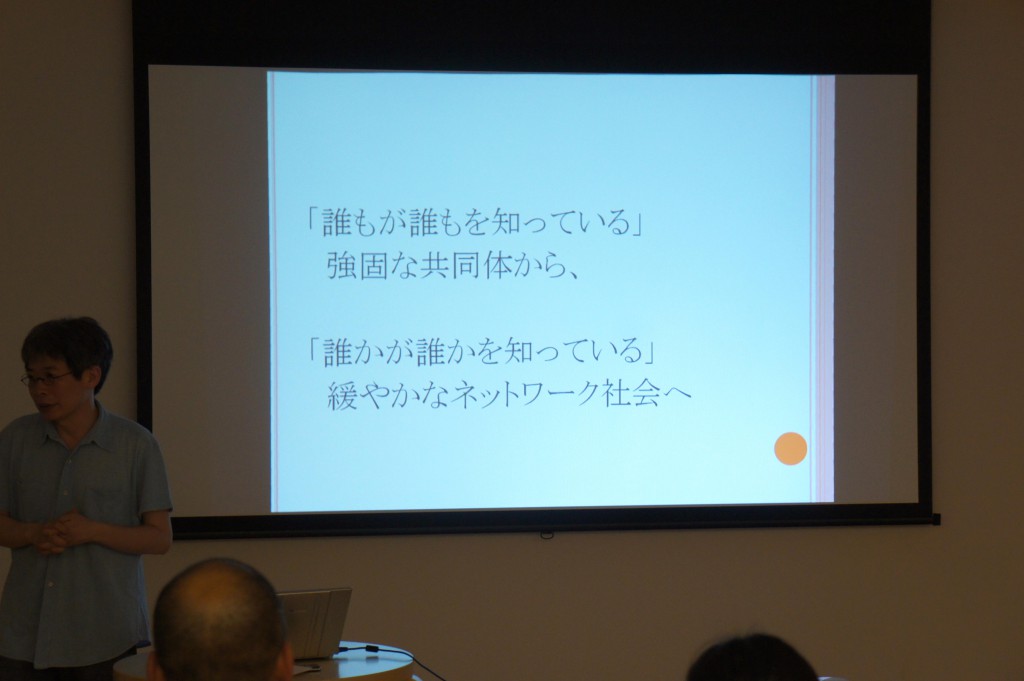
Once the performances had finished, Mr. Hirata concluded his workshop, which had mainly focused on communication, with a lecture on “the role of arts in society,” where we discussed the meaning of museums and theaters as social devices. Below, I will introduce Mr. Hirata’s lecture while including my own explanations.
According to Mr. Hirata, before thinking about “how museums and theaters should function in society,” we must first re-think about the environment in where they are located. If you look back, because of the recent expansion of large suburban supermarkets in the provinces, it has become possible to get good products at good prices all year round. The more rural the area, the more shopping districts become deserted since they are so easily influenced by market competition. Bookstores and electronics stores are disappearing, as well, and Mr. Hirata contends that you will see the same scenes all over Japan no matter where you go. In order to compete against the large stores that have a high cost performance, regional family-owned stores are forced to focus on cost-effectiveness and can no longer afford to allow any waste. These days, small art galleries, photo studios, and even places for children to gather like mom-and pop candy stores are disappearing. In contrast, large cities like Tokyo and Osaka still have strong consumer activity, and therefore, used book stores and jazz cafes in shopping districts can still survive. At a glance, large cities may seem to be busy and bustling, while the countryside has an image of being laid-back. However, there seems to be a big gap between this perception and reality.
You can no longer rely on the owner of a used bookstore to foster the growth of literary youth. Mr. Hirata points out that, in conjunction with a delay in government response, the cultural gap between cities and the countryside is increasing, as well as a big difference in competitiveness.
What is more problematic is that in the countryside, where there is no longer room to allow waste, people who are societally disadvantaged, such as the homeless or school dropouts, now have no place to go. Some of these people will drop in to a karaoke booth or a convenience store, and homeless people may head to local libraries. In recent years, there was a distressing incident where a homeless man who scolded rowdy junior high school students in a library was beaten to death. Mr. Hirata says that, in order to avoid incidences like this, society must frame itself in a way that allows anyone to participate easily, even if you are societally disadvantaged.
Mr. Hirata proposed the idea of “social inclusion” to address these problems. While adding my own explanation to the concept of “social inclusion,” my understanding is that we should lend our hands to those people who, for whatever reason, are (or may be) socially isolated due to unemployment, poor health, old age, or mental instability in order to help them reintegrate into society. This will create a society that doesn’t isolate people. By recognizing and respecting each other’s existence, and by gradually building a supportive community, we aim to build a safety net against the confusion in the event of a solitary death or disaster.
According to Mr. Hirata, pre-war Japanese culture created a society where they planted and harvested rice together and everyone knew everyone else. However, recent generations dislike feeling obligated by strong collective organizations to do things such as joining the local chamber of commerce, or taking part in all local events such as the Japanese Bon Dance in the summer or the festivals in the autumn. In addition, it can be said that most people’s human interaction and activities are more limited to their commute between their home and school or work place, and there are fewer places where they can retreat into a mental safe haven. This is creating an environment in which modern society people can easily isolate themselves even more. In order to respond to these issues, society needs a “third place” suited to modern society that can come also withstand market principles which is not school, or your workplace, home, karaoke box, or convenience store. Mr. Hirata said that these third places could possibly be museums, music halls, libraries, theaters, or basketball courts, for example. People oftentimes say that museums and theaters are extraordinary spaces. Not “out of the ordinary” (as in, say, a haunted house), but extraordinary, as in a place where people who would most likely not meet otherwise according to economic principles will be able to meet each other despite their differences.
Mr. Hirata points out that there is a need to change Japanese society from an “everyone knows everyone else” type of strong collective entity to a “someone knows somebody” type of Loose-knit Network Society, by providing the opportunities to create connections with other people who come to these extraordinary spaces wherein everyone is on equal footing. For example, “That grandpa seems grumpy, but when he participated in volunteer activities, he was amazing.” or “That Brazilian guy looks tough, but he is great when he teaches soccer to kids.” Now museums and theaters are getting more and more attention as societal devices to support a “someone knows somebody” type of Loose-knit Network Society.
Mr. Hirata continued on and introduced us to the cases of social inclusion in post-’80s museums and theaters. After the ’80s, people in the West emphasized the revival of cities by setting up art centers to easily integrate various minorities into local culture. It is said that the art centers were built from the design stage based upon the users’ opinions as to what kind of environment would be needed for the creation of a place for societally-disadvantaged people, such as Hispanic and Chinese immigrants, single mothers, the disabled or elderly, to easily become a part of society through arts. In Japan, sometimes voices of residents are heard, but it is very difficult to integrate the voices of these end-users’ voices when most of the plans are made by people with power or education. Also, it is important for the socially powerful people, like town assembly members and CEOs to participate in the process at the same time. We need to create a system where those people’s power can be returned to society through theaters and museums. The cultural facilities in Japan are not yet there, however.
Also, a typical example of “social inclusion” in the West comes in the form of Homeless Projects which provided opportunities for the homeless to take a shower and go see a show. Homeless people in developed countries are typically not homeless from birth, so many of them have dropped out of society from some reason or another. We hoped that they will get back the stamina to survive by being exposed to artistic things they may have previously enjoyed. They may reminiscence, “When I was a kid, I used to go to concerts with my mother….” “Oh, I used to like the opera…” If this could give them the motivation to work, it will be a very cost-effective method for the government to help prevent homelessness.
In contrast, if you prepare meals for them – even though it could save their lives – it will not be radically prevent homelessness. This is because the majority of the reasons people become homeless are mental. Of course, there are economical reasons as well. But if it were solely economical reasons, they could get social welfare, so there must be other reasons that they became homeless as well. There is a need for some type of psychological care for them in order to resolve it, and Mr. Hirata says that art plays a big role.
It is said that, even in Japan, there are examples of social inclusion through arts. One of the most well-known examples is when daily workers in Kamagasaki, Osaka and homeless people collaborated to create a picture story theater group and performed together at places such as retirement homes. Recognizing that they are contributing something to society positively affects their emotional well-being while increasing their motivation to work, which may help them grow enough to attend the Edinburgh International Festival.
Also, the “Komaba Agora Theatre,” which is owned by Mr. Hirata, has offered a huge discount of 70% off to recipients of unemployment insurance for the last few years. This measure is widely implemented in European theaters and museums, but is not yet implemented in public halls in Japan. In the past in Japan, people probably thought that unemployed people going to see a show at the theater implied they were neglecting their job search. When the economy was booming, anyone could find a job within six months and there was a strong impression of the unemployed being lazy. However, the economic situation is not the same anymore, and unemployment is beyond our own responsibility now. Becoming unemployed regardless of how hard you work can cause a chain reaction of “social exclusion” (due to unfavorable factors from your past, like unemployment, divorce, illness, etc. can accumulation and create a connection to “social exclusion” outlook: leading to lack of a place to live and social relations, and not becoming a part of society). Thus, it can be said that we are living in an environment which has of high possibility of becoming isolated from society. We live in an environment that is easily prone to “social exclusion” based on economic principles. And thus, “social inclusion” that mainly revolves around “extraordinary spaces” such as museums will effectively function as a countermeasure.
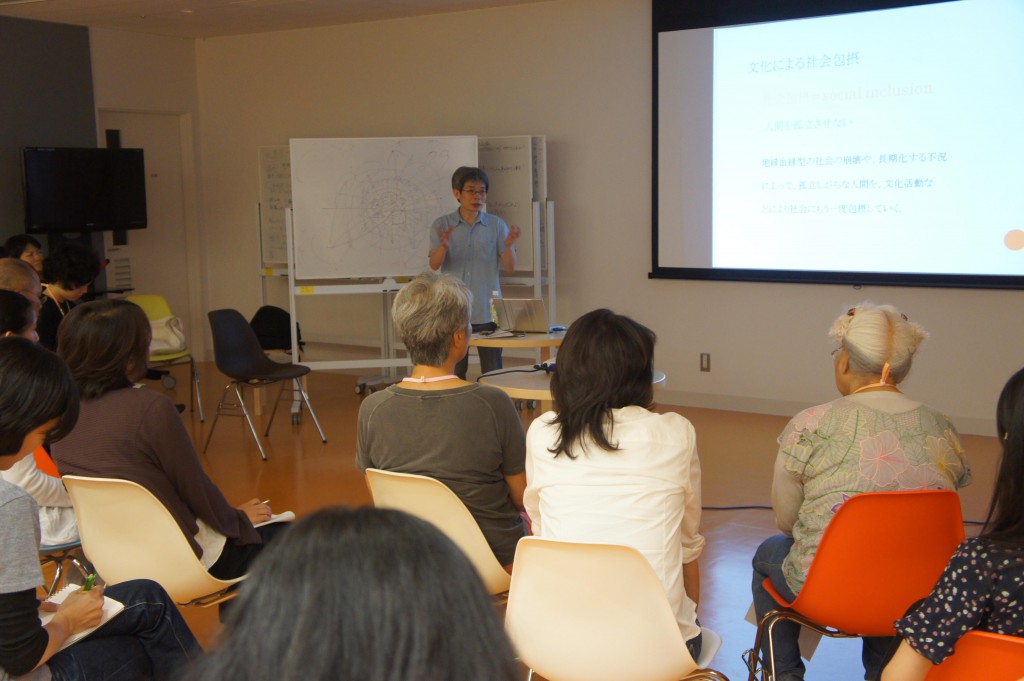
Mr. Hirata’s concept of using museums as the “third place” is precisely in line with some of the philosophies of the TOBI Gateway Project. (The philosophy of the TOBI Gateway Project is explained in “Bringing out the Community through Art (at The University of Tokyo).” However, the biggest difference between the structure of the TOBI Gateway Project and the structure of Mr. Hirata’s “social inclusion” is that the TOBIRAs are highly skilled and select elites in society, and their community shares a wide variety of values by intelligence, so they do not include societally disadvantaged beings who need social inclusion. However, it is possible to approach the concept of “social inclusion” by thinking of how we can create a gateway between the museum and society by returning the power of museums back to the society by taking TOBIRAs’ individual skills into the equation. For example, it is possible that numerous workshops and seminars created by TOBIRAs – not only the regular museum programs – may become the motivation for people with differing values to begin visiting museums. Then, by having many people participate in these programs, it may facilitate the creation of a “somebody knows somebody relationship.”
Mr. Hirata said that, according to statistics and surveys, people will travel within a 30-minute drive without stress, as long as there are events like advanced art and cultural activities, environmental protection activities, or sports events in which they want to voluntarily participate. Therefore, there is no problem with developing a broad range of programs. But instead there is a tendency for people to only come to things that they are interested in, so it is important to have various interests in mind when building communities.
Mr. Hirata introduced us to an example where people who are participating in local communities shared ideas. Through creating several entrances (gateways), they could effectively create a link with the outside people who have a variety of values. In the Tenjinbashi-Suiji Shopping District in Osaka, there is a Rakugo theater called “Tenman-Tenjin Hanjoutei.” Since Hanjoutei seats about 200 people per show, you might think that it would not contribute much to the shopping district. As young Rakugo story tellers started hanging out in the shopping district’s izakaya [Japanese-style pubs], and the local businessmen started to join them. They would get together and talk about stupid stuff and have a great time almost every night. Funny Rakugo story tellers and locals that were connected to the area eventually turned the ideas thrown out over drinks into realistic events for the locals. For example, people threw out whatever ideas they had for events such as, “A Field Trip of One-Day Apprenticeships” at the shopping district, granting a “Certificate of Walking from End to End of the Shopping District,” and “Street Performance Championship,” etc. You might say that these are silly ideas, but the district was crowded beyond what anyone could have imagined – ideas that people liked would turn into actual events within the next month, and these events created a gateway to draw in a large number of people. It was truly a “soft local production for local consumption.” Nowadays, it is surprising that there are more than 25,000 people walk through this shopping district every day, making it Japan’s busiest shopping district.
When you think of the Hanjou-tei as an example, the number of customers could be the basis for the evaluation of operating cultural facilities. However, if the role of cultural facilities is to give energy to the local community, then the number of visitors alone cannot be a reliable measure of their value and effectiveness. It can be said that having the Hanjou-tei there, the Rakugo story tellers, and local businessmen all getting together over drinks were all important cultural factors to the [the success of] Tenjinbashi-suji shopping district. And most importantly, the miracle of becoming the “Japan’s busiest shopping district” was achieved because of all the locals who love “Tenman Tenshin Hanjoutei.”
I felt that the story of the Rakugo story tellers and local businessmen is similar to Mr. Yoshiaki Nishimura’s example of “the style of not prioritizing the mission, but whoever happens to be there is everything” in our “5th Foundation Course: Research on How TOBIRAs Work.”
When operating things such as cultural facilities and cultural projects, whether or not you are loved by the locals and using creativity to make the locals love you is a very important point. The TOBI Gateway Project is the same way. In recent years, projects connecting the local community and art, such as the “Echigo-Tsumari Art Triennial” and “Setouchi International Art Festival,” are gaining more and more attention. It can be said that they have become a success through artists coming face-to-face on the soil with the local community’s unique nature and history and creating original art in the local community that moved the locals’ hearts. Also, these processes resulted in the achievement of a creative time and space where regional and global characteristics can coexist, and despite being held in a suburban city, the Setouchi International Art Festival recorded 940,000 visitors.
Using these art projects as examples, Mr. Hirata expressed the importance of Cultural Self-Determination Ability– such as “what are your own values?” and “what can we do to appeal to more people for regional developments in the future?” If we cannot cultivate our own Cultural Self-Determination Ability and instead rely on others to decide our own culture’s values, then the regional unique cultures will be swallowed up with big cities’ capitalistic tendencies, like a failure story of a Bubble Period’s city plans, and things will only go downhill.
—I believe that Mr. Hirata’s lecture could be a guiding philosophy for the TOBI Gate Project. Also, there were many parts that overlap with our own projects, which made me feel like we had received a great deal of support. Going forth, we would like to devote ourselves to see how much of the ideal we can turn into reality. (Tatsuya Ito, Manager, TOBI Gateway Project)
2012.06.23
After the last Foundation Course ended, we had meeting and closing party for the Foundation Courses at the Restaurant Ivory in the Tokyo Metropolitan Art Museum from 6 o’clock in the evening. With the conclusion of all six Foundation Courses, the TOBIRA candidates (hereinforth: TOBIKO) had developed quite good relationships. I think the Foundation Courses were quite difficult, but everyone worked hard.
All the members of the TOBIRA Band, who I previously introduced in this blog, also appeared. They performed the well-known NHK song “Metropolitan Art Museum” because the Tokyo Metropolitan Art Museum is a Tokyo Metropolitan Museum. The TOBIRA Band performance in the costumes with the matching blue turbans made by Tokita-san, one of the TOBIKO, were like a symbol of the work completed in the two months since the TOBI Gateway Project began.
This “Girl with a Pearl Earring” is Ōhashi-san, the supervising curator of the Mauritshuis Gallery exhibition. It looks quite good on her! Also, taking the timing into consideration, I’d really like to have a meeting of all TOBIKO. Next up are the Practical Courses. Let’s all do our best! (Itō)
2012.06.23
The Foundation Courses, six classes in all, finally held the last session. The instructors for this class were curators Ms. Sawako Inaniwa, Ms. Yumi Kono, Ms. Natsuko Ohashi, and myself, Tatsuya Itō. At the beginning, Ms. Inaniwa and I once again reviewed the summary of the art communication that the Tokyo Metropolitan Museum (hereafter: TOBI) aspires to.
As this was the last one, everyone was more serious than ever in class.
Over the period of the Foundation Course from this April to June, we asked the TOBIRA candidates (hereafter: TOBIKO) to choose at least one program out of the following: “School Monday (School Collaboration: Art Viewing through Conversation),” “Architecture Tour,” and “Access Program (Supporting Special Viewing Events for the Disabled)” and decide the general direction of their future activities. The TOBIKOs must attend at least 80% of their chosen program’s Practical Application Courses. And we strongly recommended they take on a leadership role of the program in the year after completion of the Courses.
In order to share the characteristics of each program, we had the curator in charge of each explain the details. Ms. Kono, the curator in charge of the “Architecture Tour,” went first. The Architecture Tour Practical Application Course has already started, and it has been mentioned in this blog as well. This program plans tours to introduce the Tokyo Metropolitan Art Museum, a building created by Mr. Kunio Maekawa, an exemplary Japanese architect who studied under Le Corbusier. Rather than stereotypical architectural tours, we are aiming for architecture tours full of originality created by each individual TOBIRA.
Next, Ms. Ohashi provided us with an explanation of the “Access Program (Supporting Special Viewing Events for the Disabled).” At TOBI, we schedule Special Viewing Events for the Disabled three times a year. Utilizing the days the Museum is closed, the TOBIRAs set up a day for people with disabilities to view the art pieces safely and with ease. The first special viewing for the disabled is the “Masterpieces from the Royal Picture Gallery Mauritshuis,” where Vermeer’s “Girl with a Pearl Earring” is displayed.
Lastly, came Ms. Inaniwa, who is in charge of the “School Monday (School Collaboration: Art Viewing through Conversation)” project. This is a program to offer TOBI as a place to practice art viewing education in collaboration with elementary and middle schools. Since there are many visitors normally, we utilize the days that the museum is closed and offer conversational viewing education that centers on VTS (visual thinking strategies) for special exhibits for which it is difficult to offer practical viewing education.
“School Monday (School Collaboration: Art Viewing through Conversation),” “Architecture Tour,” and “Access Program (Supporting Special Viewing Events for the Disabled)” are three pillars that support the activities of the TOBI Gateway Project. Also, even outside the activities of the program they selected, we recommend that people step out of the framework of the program and participate such as when there is not enough staff, when we are in need of more support, or when the subject is extremely interesting to them.
In addition to an explanation of these three main programs, the morning Foundation Course ended by going over TOBI’s exclusive information sharing systems, including our mailing list, the “TOBI Gateway Project Bulletin Board,” and “Today’s White Board.” For anyone outside of the TOBI Gateway Project that keeps up with this blog, you might have noticed the banner at the top of the homepage that says “TOBIRA Private Bulletin Board.” When you click it, two banners show up: “TOBI Gateway Project Bulletin Board” and “Today’s White Board.” Unfortunately, you will not be able to see anything beyond this point unless you are a TOBIKO. Actually, the system beyond this point has TOBIKO meeting minutes uploaded with each White Board picture, post-meeting impressions and additional information. There has already been lively activity beyond our expectations.
In the afternoon, under my facilitation, each TOBIKO gave a presentation on a number of new projects they are managing which are presently underway. There are already more than 10 projects that can only come from the perspective of a TOBIKO, such as the “TOBIRA Band,” where TOBIKO who can play instruments and get together to perform; the “TOBIRA Information Department,” where TOBIKOs aim to share and disseminate information about TOBI and the Tokyo National University of Fine Arts and Music through newspapers, blogs and other media; and “Map & Manual,” where they create TOBI maps and think about knowledge sharing to support TOBIRA activities. By carefully presenting the projects one by one, they discovered projects that could help each other, and asking questions lead to the birth of new ideas – it was a very productive presentation time.
The projects have only just begun, so their realization of each project depends on the efforts of the TOBIKOs. Every TOBIRA staff member would like to support the TOBIKOs as much as possible.
That’s the way I was feeling. But on the other hand, as a project manager, I believe that the TOBIKOs sharing and discussing thoughts and ideas using the activities they came up with from their own viewpoints as a trigger is an asset and a very important process for the growth of the TOBI Gateway Project. (The “Power of Listening” makes this possible.)
What connects approximately 90 TOBIKOs – people whose ages and occupations vary – is the platform called “art.” Of course, I believe that there are many platforms other than art that can hold people’s various values. However, there seems to be no other platform that can so lightly transcend yet widely and flatly embrace such diverse genders, ages, occupations, and value systems, in the way that art can. Since art is a framework for incomparable possibilities, I believe that art can function as a convertible medium in establishing community. (Perhaps art has such a timeless, universal appeal and value in and of itself that it can become such a large frame.)
By defining art as our platform, a large variety of TOBIKOs can work in harmony and build trusting relationships – something which we believe builds the backbone of the TOBI Gateway Project.
Oftentimes people use analogies like “Art is the backbone of society” or “Art will produce effects on society gradually, like Chinese medicine.” If art exists as the platform to support people’s wide variety of values, it must indicate that social capital (social capital: the idea, proposed by American sociologist, Robert Putnam that various people interact and build relations itself is the base of society’s capital) is stored at a high level in the society (community).
Even for the TOBI Gateway Project, the accumulation of social capital is a high priority. Showing the understanding of differing value judgments, building trust beyond such characteristics as age and social status, and more than anything, if you are not able to build relationships where you can share such things as your problems, risks, difficulties and failures, then you cannot truly say that social capital is accumulating in the TOBI Gateway Project.
Also, this discussion does not just end with the TOBIKOs. We absolutely want this capital stored up amongst the people who work in various capacities at TOBI. Basically, we would like to save up social capital within TOBI. In fact, the essence of this year’s TOBI Gateway Project activities lies there. If we do not create a strong backbone in the TOBI community by building a stock of social capital, the image of TOBI as a social device that “forms an open and practical community promoting communication through art with the Museum as a base” – will be nothing more than a dream. Although the expectations for the TOBIKOs will only grow, that’s okay. I am sure that the members will be able to meet these expectations because our intent was to pick TOBIRA candidates with the “perseverance to engage in dialogue and the power to treat it with sincerity.” (We also felt that the longtime volunteers supporting the Special Viewings for the Disabled before the Museum closing share these qualifications as well, so we made them become TOBIRA candidates as a group.)
Lastly, we got to provide technical advice to the TOBIKO to make progress on their projects going forward. First, the instructor Nishimura-san went over the written contents of the “TOBI Gateway Project Bulletin Board.” After that I offered my own advice. These are some points needed to turn your enthusiasm into a driving force. I think results will change drastically just by keeping them in mind.
Three points from Nishimura-san:
1. In any type of project, it is good to share a way to end it or an image of its dissolution at the beginning. For example, “we will dissolve when we achieve xxxx,” or set a time limit with “automatic dissolution at such and such a time,” and so on. When the time comes to dissolve, if there is still a feeling of “Let’s keep working!” then you can start on point 2.
2. Experiences such as where you keep encountering pointless connections, should you just automatically dissolve or evaporate? Since this won’t affect the relationship positively in the future, it is good to share a way to dismiss at the beginning. When you dissolve, everyone should have fun!
3. You shouldn’t use a system of “throwing ideas out there and waiting for people’s responses.” Go as far as you can on your own.
Itō’s 3 points for having a meeting (+1 extra)
1. Quantify the image (specify the schedule and amount of money, etc.).
2. End the meeting by switching to tasks (jobs).
3. Think about a balance between the amount of work and the collection of results. (It may not apply to the TOBI Gateway Project, but people often say “The result would have been the same even if we had not put together that document…” It is pointless to get satisfaction from making the document.)
+1 And the most important thing – Share your workload before it gets too rough and makes you feel like “I can’t handle this!” The most important thing is to “send” and “receive” warnings.
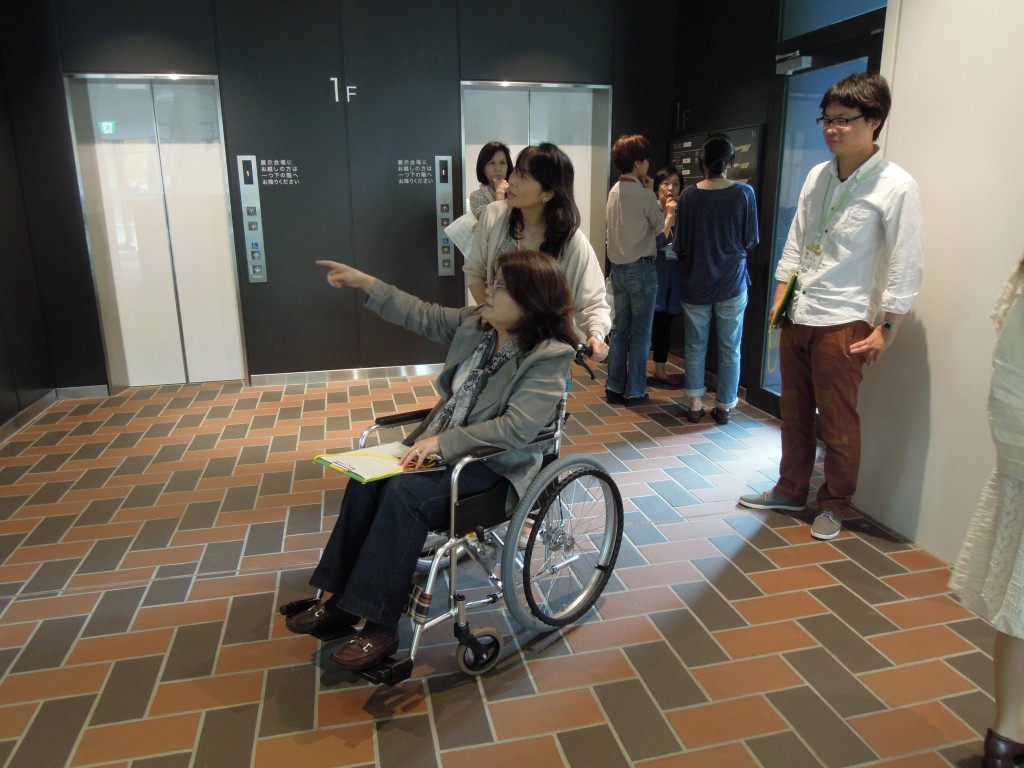
After the last Foundation Course ended, TOBIKOs voluntarily divided themselves into a variety of self-run planning groups and met until the evening. Amazing! This photo depicts them in wheelchairs checking Museum accessibility for the disabled.
All six Foundation Course classes have now finished. Now we will move onto the Practical Application Course. It’s going to be the real thing from now on! (Itō)
2012.06.19
The 2nd Practical Application Course on Architectural Tours was held. This time, participants mainly studied the characteristics and history of the Tokyo Metropolitan Museum (hereafter: TOBI) building. The instructor was the curator, Ms. Kono. She mainly lectured about the fundamental knowledge that TOBIRA candidates (hereafter: TOBIKO) would want to know when guiding a tour on-site. She also lectured on a wide range of topics, including a little behind-the-scenes story. The photo on the slide is of Keitaro Satō, the king of coal mines in Kyushu, also known as the “father of TOBI.” He donated 1,000,000 yen at the time (approximately 3,300,000,000 yen today) to the City of Tokyo and contributed to the opening of the Tokyo Museum (Now, Tokyo Metropolitan Art Museum) in 1926 (Taishō 15).
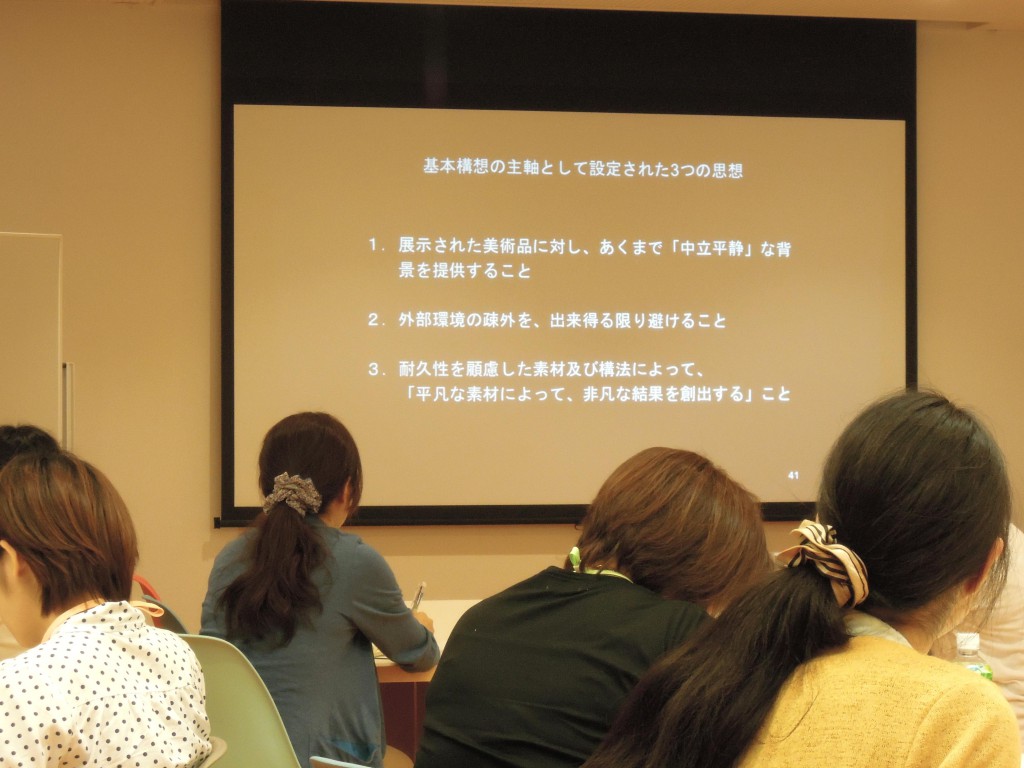
The old Tokyo Museum built with the donation from Mr. Keitaro Sato was forced to rebuild over time. In 1975, the migration from the old Tokyo Museum to the current Tokyo Metropolitan Art Museum designed by Mr. Kunio Maekawa was completed. Surprisingly, they built a new building right next door while they were running the old one – it was like an acrobatic transfer. Also, Mr. Maekawa worked on the design of the Tokyo Bunka Kaikan [cultural hall] in Ueno Park, and the National Museum of Western Art, located on the opposite side, is a piece by his mentor, Le Corbusier. On the other hand, natural scenery such as Shinobazu pond and the Musashino primeval woodland remain in Ueno Park. Construction of TOBI was carried out under Mr. Maekawa by fusing this varied beauty while paying respect to the environment of the entire park surrounding the museum building.
Additionally, once you look inside, the TOBI building has various creative things hidden that people normally do not notice. For example, the handrail on the stairs inside the Museum has been processed so that all of the corners are removed and rounded. This is because when TOBI was built back in the early 1970s, many of the Museum visitors still wore kimonos. It was designed to prevent kimono sleeves from getting caught on the handrail. We can still see this, even after the renovation. Beyond that, there were many things that made us admittedly nod our heads in recognition of their creativity, such as the “snagging process” creating the impression of soft light and shadow from the indentations made on a once beautifully hardened concrete surface and the tile placing method which makes the outside wall covering TOBI look like bricks at first glance.
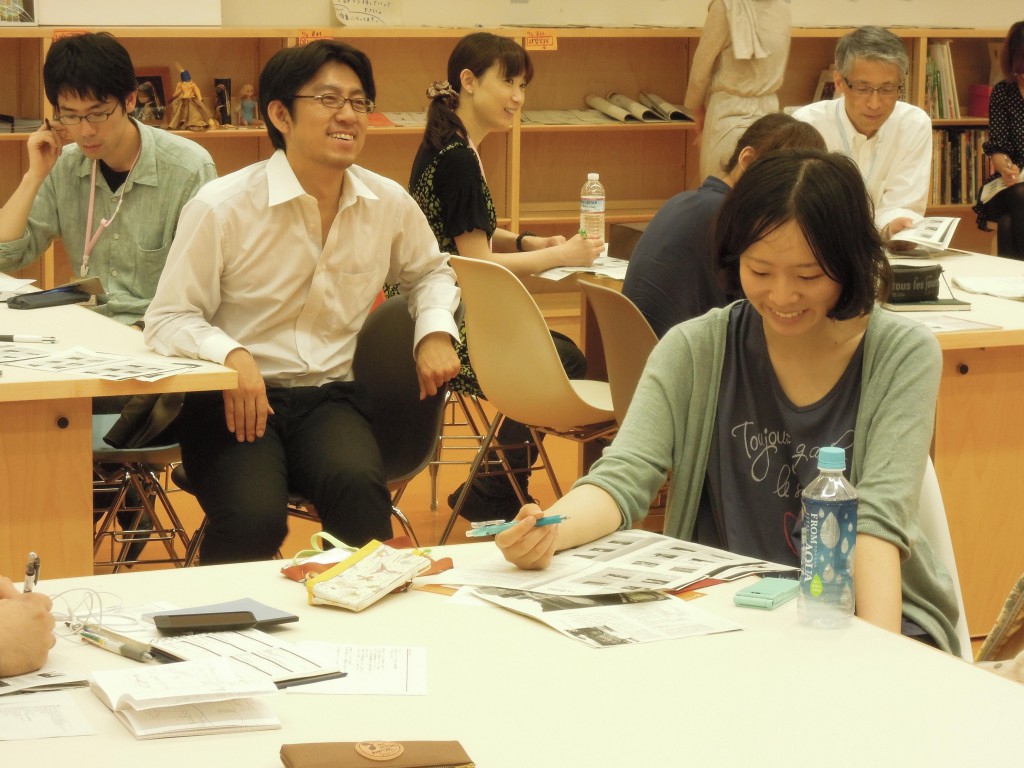
One memorable historical episode is the story of a large slanted gash that still remains on the concrete at the TOBI main entrance. In the early ’70s, when TOBI was under construction, Japan faced an oil crisis. As a result of this, there was a state of panic when a concrete mixer could not arrive during the construction of the entrance. The concrete to replenish the supply was never delivered, and the already added concrete had started to harden. As a result, the outline of the break remains deeply visible. It is said that the person in charge at the site kneeled down on his knees to apologize for the mismanagement to Mr. Maekawa, but he simply responded “This is a scar of the times. It looks like the ridge line of a mountain; I think it’s fine as is.” It’s an intriguing story.
Stories about TOBI never end. Currently, the TOBIKOs are studying for the upcoming architecture tour. The next Practical Application Course on Architectural Tours is still a month away. Until then, the homework for the TOBIKOs is to create our own tour plan. I am really looking forward to the tour ideas that will emerge. (Itō)
2012.06.09
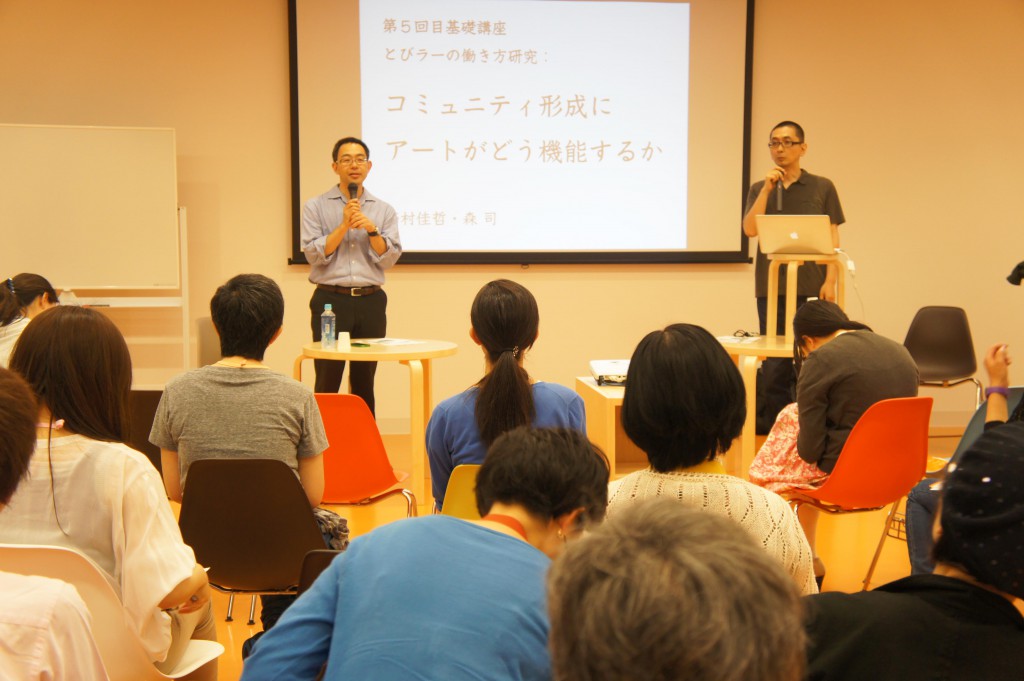
The theme of the 5th Foundation Course is “Research on How TOBIRAs Work.” The lecturers are Mr. Yoshiaki Nishimura (working methods researcher / Living World representative) and Mr. Tsukasa Mori (Section Chief, Tokyo Culture Creation Project, Regional Cultural Exchange Section, Tokyo Metropolitan Foundation for History and Culture). With the Foundation Courses coming to a close, from here on the TOBIRA candidates (hereinafter called “TOBIKO”) will see how they can actually work in the setting of the Tokyo Metropolitan Art Museum (hereinafter called “TOBI”). This course was held for that possibility and preparation.
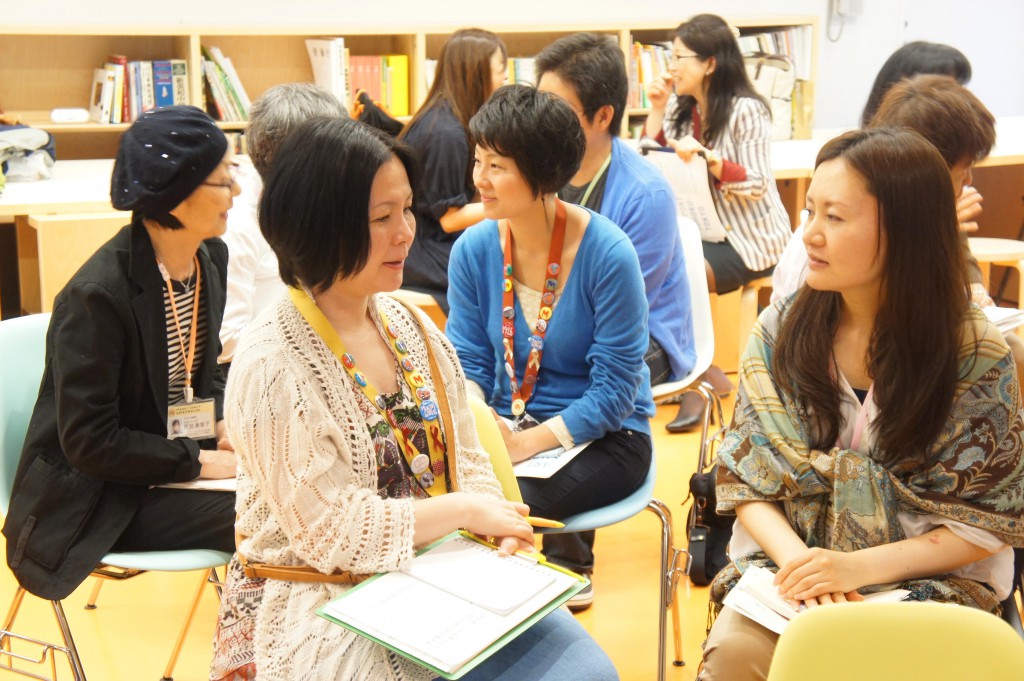
At first, Mr. Nishimura put forward the theme of “The TOBI Gateway Project and Who I Am Now.” When the Course participants became TOBIKOs, they became quite familiar with TOBI and developed bonds with other TOBIKOs. Different plans began to sprout, and he has begun to realize the great expectations and challenges of conduct for TOBIKOs. To look back a little on the present, the TOBIKOs paired up and discussed their recent circumstances. Of course, the most important issue was “listening ability.” Mr. Nishimura once again advised that “listening ability” means “truly having an interest and concern in that person.”
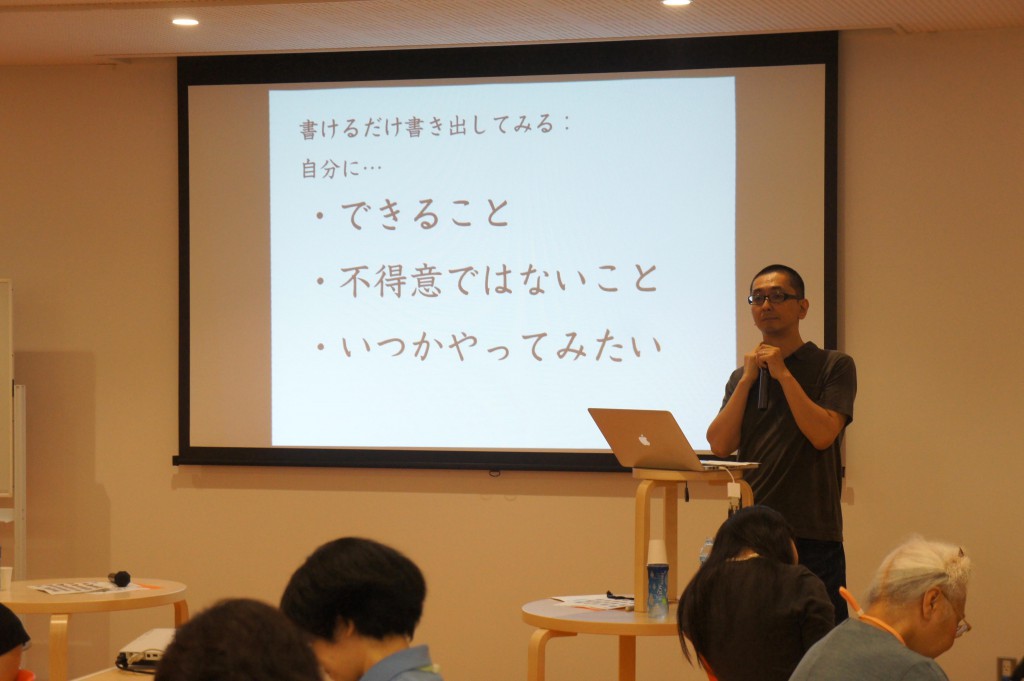
After that, Mr. Nishimura spoke about “the style of not prioritizing the mission, but whoever happens to be there is everything” with the example of a talk by Mr. Hideki Toshima (originally at Graph) who he met at a lecture titled “3 Days to Think about one’s Work” (2009). He worked on such projects as the installation design of Mr. Yoshitomo Nara’s works, and he said that the design company Graph, performing on a global stage, was started by 6 friends who gathered together with their canned coffee drinks on the stone steps of the Nakanoshima Public Hall in Osaka. At that time, people such as half craftsmen or cooks gathered after work to talk about the current circumstances of such things as each other’s dreams and work. In that situation, one of the members made a chair, and at that point Graph’s activities started to move. Graph grew rapidly with the chain of ideas “If you can make a chair, I’ll go sell it. If we can sell it, we’ll need mass production and that will require a studio, right? If so, then let’s rent a building, then we can make a showroom, then I will have a café there.” They didn’t decide on their mission and goals and then recruit the people with the necessary abilities, but potential sprouted from the people who happened to be there. This vague method of sharing things like each other’s dreams and potential to find the shape of the future by thinking “it’s something like this” is “the style of not prioritizing the mission, but whoever happens to be there is everything.”
This “the style of not prioritizing the mission, but whoever happens to be there is everything” is the actual common point with the “day after tomorrow potential” that the TOBI Gateway Project envisions. (For more about “day after tomorrow potential,” please refer to “Educe cafe: Bringing out the Community through Art” that took place on June 6th at The University of Tokyo.) I want the TOBI Gateway Project to take great care of the various faces that gather at TOBI and the vague image of the future arising from accumulating achievements which are only possible at TOBI.
To tell the truth, the image of the activities for the TOBIRA Gateway Project wasn’t firmed up when planning began. Not even the curator, Ms. Inaniwa, myself (I really hadn’t even dreamed that I would be the Project Manager) or any of the instructors had even imagined anything at this time last year. However, we met, spoke with and shared feelings with people, we thought and became impassioned, and bit by bit, we built the principles and direction of the TOBI Gateway Project. It can really be said that the form of this TOBI Gateway Project came about exactly because of the staff that we have. So I want to have the same stance in connecting with the objective of TOBIRA activities.
Whether these thoughts were certainly included or not (I’m not sure), Mr. Nishimura next instructed us to make groups of three people from the members gathered here and for those people to think of unique ideas. He said that the image of the smallest social unit is three people in a group. They soon made groups of three people and began with each person writing in a notebook “what I can do,” “what I’m not bad at” and “what I’d like to try sometime.” After writing in the notebooks, they chose just one of those words and wrote it on post-it notes that were distributed.
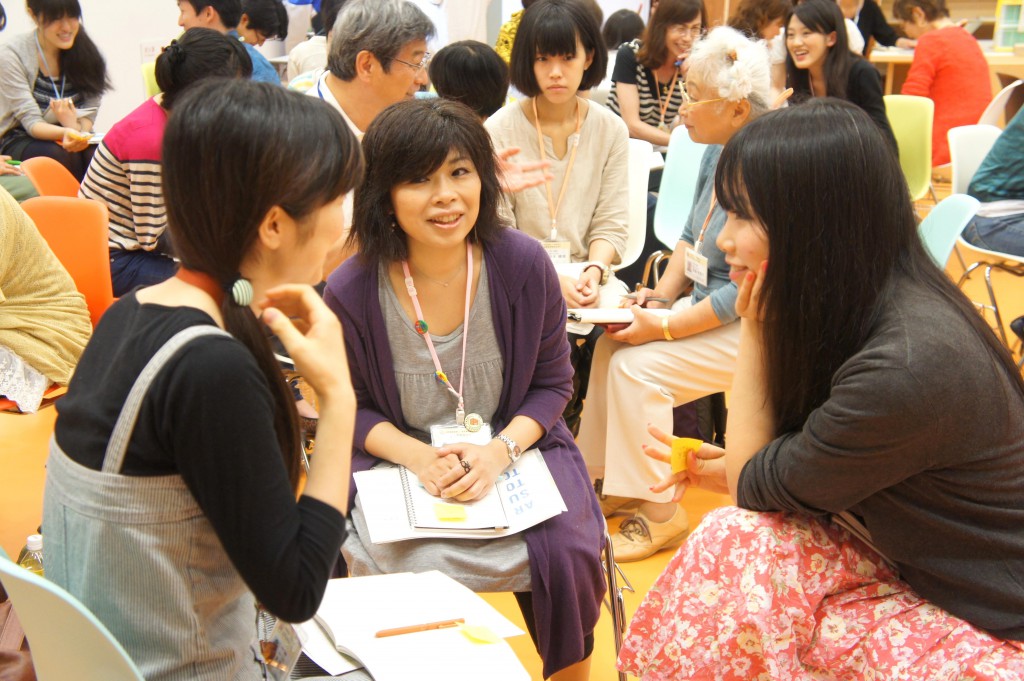
They showed each other the post-it notes with the words they chose, and the three members thought of an idea from those three words. At first, they came up with ideas unrestrained by the place called “TOBI.” Since they came here, this was the first time they realized that the other TOBIRA candidates had unexpected special skills that were many hidden hints which may be useful in future activities.
After the three members tried once to form a simple planning idea, they then continued deepening the image. Next time, these three will think about what they can do at TOBI. While discussing what they themselves can do in the setting of TOBI bringing their three words, the morning ended. Each group was then assigned homework to submit their plans on one A4 sheet of paper by the afternoon, and an active meeting continued even into the lunch break.
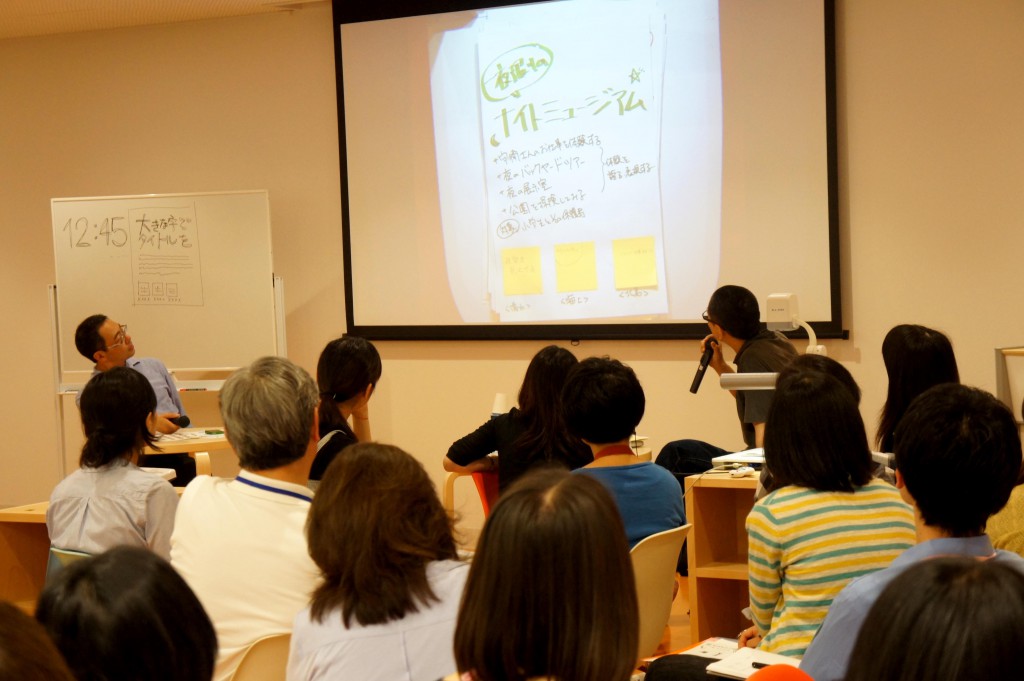
Lunch break ended and the afternoon session started. Mr. Mori joined and checked each of the plans. With Ms. Shiomi, (“I want to go skydiving”), Ms. Komatsu (“I want to travel all over Japan”) and Ms. Hirano (“I want to be in the newspaper for something other than a bad thing”), it was like “TOBIRAs jumping out of the sky.” (Laughs) “TOBIRAs will skydive into all parts of Japan. We will have the letters ‘TOBI’ written on the parachutes. We will take pictures where we land and display them at TOBI.” There’s no way that will work. Other than that, a lot of unique ideas like a “night museum” and “Roaming around and cleaning TOBI” came about.
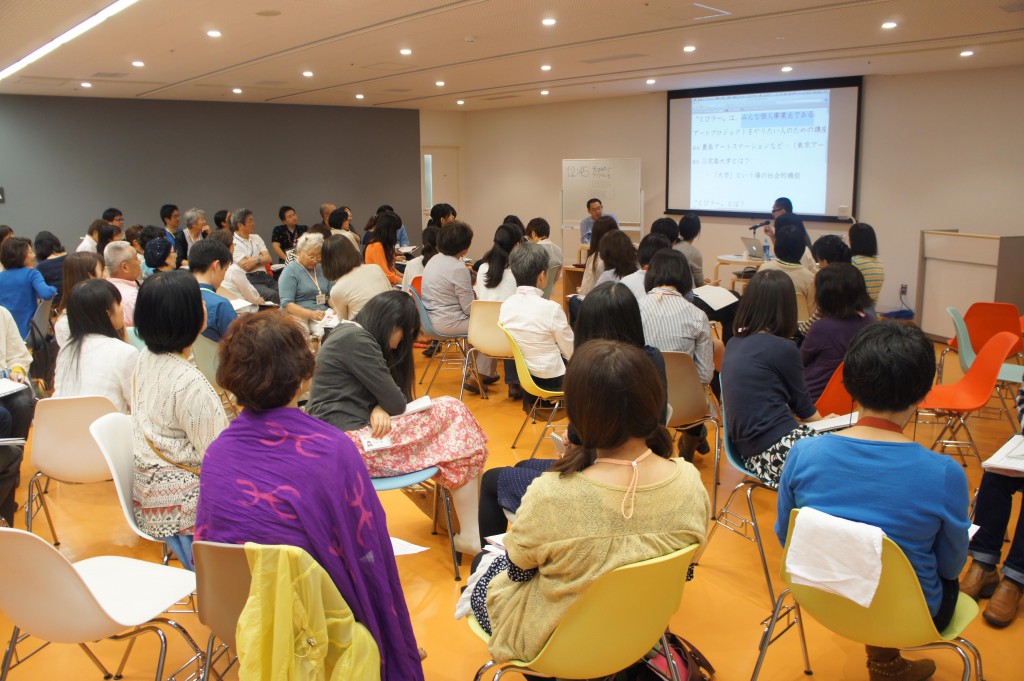
Mr. Mori provided severe and pertinent advice combining both realistic and not realistic ideas such as “Planning means that, even while you are expanding an image based upon many ideas, you should be taking it down into a simpler action plan” and “an itemized plan just consisting of a list of everyone’s ideas isn’t called planning.”
After comments on the planning reports had once finished, Mr. Mori said the sharp comment: “A lot of ideas emerged, but from here the problem is who exactly is going to carry them out?” Then, the expectations of TOBIRAs were expressed with the term of a “new public commons1.”
As my own little addition to “new public commons,” in the 1980s based on the thought that the town would become cultural if you made a cultural facility, there was a period called “box (building) administration (public policy focusing on the construction of public buildings)” that built the many community centers and halls. There were certain expectations such as: if you build the box, people will come and cultural activities will develop; if cultural activities occur, the effects will spread to the facility’s surrounding areas and there will be flowers and sculptures. But this didn’t happen at all. How do you use a multipurpose facility that anyone can use? They became places with no clear purpose and were even derided as “places with luxurious chandeliers completely lacking in exuberance.” The root cause of this failure lies in the idea that, “if you have the “hard,” the “soft” will naturally occur. Then, when it became clear that the energy of activities lies not in the buildings but in people, the Japanese economy fell into a decline with the collapse of the economic bubble. Ultimately, even if you make the “box,” there is no meaning if you don’t think about the contents. Rather, if you have the contents, there were claims that the “box” could depend on ingenuity. As a result, the era has been shifting “from “boxes” to people” and from “hard to soft” (because this is the time of art projects being developed in the middle of communities). The thought until now that the role of profit return to communities with boxes should now be entrusted to people and not a box is included in the term “new public commons.”
However, there is the question of “What will TOBIRAs do as the bearer of this “new public commons?” I am forced to think deeply about this as the Project Manager. When I looked from the perspective of a place to actually carry out a project, the extremely difficult point was that an actionable “plan” and an “idea” are clearly different. This is just my interpretation, but I think that “plan” can mean “strategy.” I mean, this is finding a path while making an overview of the expected future. If you have this image (even if its vague), even if things happen like you fail along the way or your actions don’t go well, you will accumulate these as results. But the failures and actions of your ad-hoc “thoughts” can easily produce discouragement and despair. You can’t waste the energy that you’ve worked so hard to store up. This is because “ideas” will go no farther than the “strategy” of doing something to the scene right in front of you. It’s difficult to have a bird’s eye view. Therefore, repeating “strategies” (ideas) without grand “strategies” (plans) will lead to extremely dangerous acts in running a project.
I think probably a general way to avoid this is to gather at the progress stage of the project and present the common “strategies” (plans) of all members each time and then proceed with an appropriate division of roles. However, I dare to say that in the TOBI Gateway Project I’m thinking of not doing that. This is also one of the challenges of the TOBI Gateway Project. Even regarding the “strategy” (plan), for example, if it were me, I would think at what step we could continue growing the TOBI Gateway Project. About all of the TOBIKO, I don’t necessarily think they all have to share one common thought about what kind of self-realization is possible and what they should do now toward that end. It’s important for each of them to find their own “path” (strategy) in their own motivation. Without deciding a permanent division of roles to build an organization, I want an organic team assembly progressively structured by the TOBIRAs, each with their own “strategy” (plan), to be able to continue painting an overview of the TOBI Gateway Project. I know that the obstacles are quite high, but Mr. Mori and Mr. Nishimura have said in their talks that “TOBIRAs are each a ‘one-man business.’” That’s exactly what I think, too. TOBIRAs aren’t volunteers in given roles.
A “new public commons” does not simply mean volunteers working. It calls into question each individual’s maturity and experience, and a very high level of performance is expected. Those that can become the “new public commons” will be the centrifugal force of activity woven into the TOBI Gateway Project. That is the great expectation of the project which I would like the TOBIKO to really feel.
Also, with these great expectations, the question of “What do you do next?” has been posed to the TOBIKO.
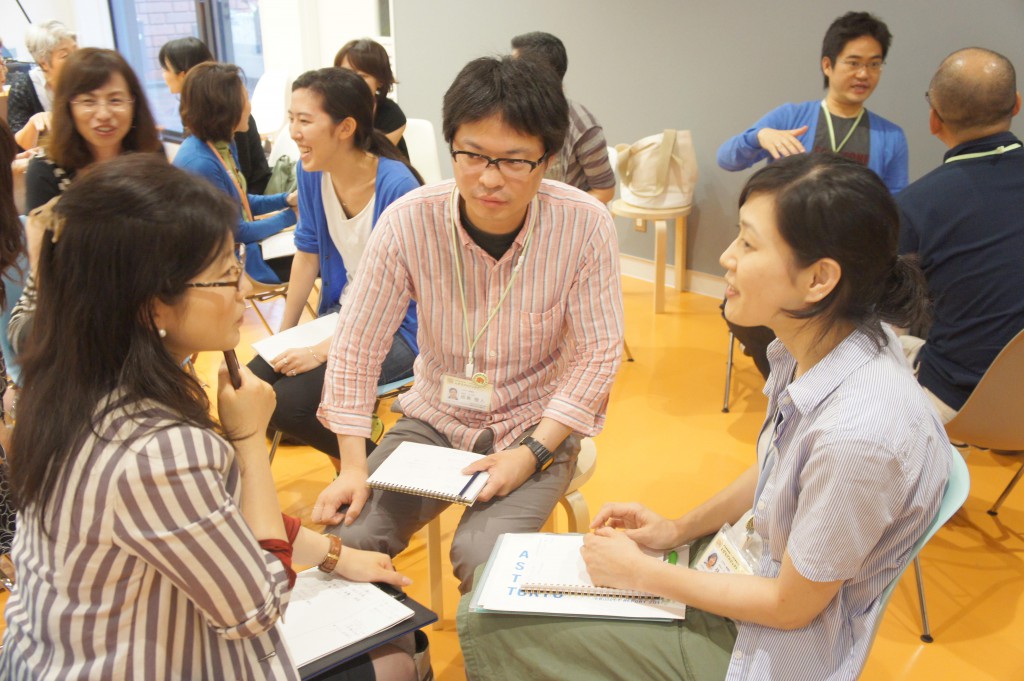
Again, with renewed feeling, we rearranged the groups of three and began talking about “What do you do next?” When thinking about the ideas of “the style of not prioritizing the mission, but whoever happens to be there is everything” and “new public commons” each being the working methods of TOBIRAs, this becomes a very important theme. There was something much deeper than originally expected in the message in the issue of “What do you do next?”
There was a submission regarding this issue not during the Foundation Course, but written on the “Message Board for TOBIRAs.” (I apologize that I cannot give those other than TOBIKOs reading this blog access to this board.…). From here, I plan to progress toward realizing that which seems capable of realization.
—I think there may be a steep road ahead toward the high ideals of the TOBI Gateway Project. With these TOBIKOs, I believe these ideals certainly can be realized. Also, aside from the staff who frequently appears in this blog, there are also staff who work hard supporting the TOBI Gateway Project. From the left, there is Ms. Manabe, our intern, Mrs. Kondo, our coordinator, Ms. Kumagaya, our part time worker, and the curator, Ms. Ohashi (in charge of the The Royal Picture Gallery Mauritshuis (Maurice House) exhibition!). (Sorry if the photo is a bit blurry.) Unfortunately, Mr. Otani, our assistant, isn’t in the picture. He’ll be there next time. Even for “the style of not prioritizing the mission, but whoever happens to be there is everything,” I think we have a great group. (Ito)
“New Public Commons” (「新しい公共」)is an idea, under which not only the government but also citizens, NPOs, private businesses, and other parties, with the spirit of mutual assistance, play an active role in providing services for our everyday life such as education, childcare, community development, nursing care and welfare services. Available at http://www5.cao.go.jp/npc/index-e/index-e.html.
2012.06.06
Curator Sawako Inaniwa (Chief for Education and Public Programs, Tokyo Metropolitan Art Museum) was invited as a guest speaker for “Educe Cafe” held at Fukutake Hall at The University of Tokyo to give a talk about “Bringing out the Community through Art.” Of course, I attended the event, along with Ms. Kondō (TOBI Gateway Project Coordinator), Ms. Ōtani (TOBI Gateway Project Assistant), and the TOBIRA candidates (hereinafter “TOBIKO”).
Being the fan that I am, I was deeply impressed with the beauty and spaciousness of The University of Tokyo campus.)
To break down the theme “Bringing out the Community through Art,” the following two questions arose: “What is the role of art in the formation of communities?” and “What kind of possible approaches could museums take to achieve them? “ These questions speak to challenges we face following the renewal of the Tokyo Metropolitan Art Museum (hereinafter “TOBI”).
First, Ms. Inaniwa analyzed the factors in creating a community in the Matsuba district of the Daito Ward where she resides: space, layers of time, the presence of introspective events and objects, places to practice, places of collective study, and sacred places. With this in mind, she explained the possibility of forming communities using museums as a social device when comparing the roles and functionality of both local museums and temples.
While using Ms. Inaniwa’s talk as a base, my impression is that, while temples and shrines are all part of our daily lives, they still can create an “extraordinary space” and be deep-rooted in people’s lives. Although I personally don’t have any specific religious beliefs, I feel like my body and soul are purified when walking through shrine or temple gates. In addition, temples and shrines are normally very quiet, but when there are festivals, tons of locals get together and even I have a great time. While Buddha and God have a special intangible existence to the locals, we incorporate them into our lives and live together in harmony.
I felt that having a fine line between an extraordinary and an ordinary space is quite important to creating a vivacious community.
These kinds of human interaction represent the ideal image of community-based museums that the TOBI aspires to be. For example: museums are also usually quiet (despite the fact that the TOBI is almost never quiet…); art exhibitions are in the back with a slightly higher threshold. Once you do go inside, there is a sense of tension to remain silent. However, when you have had a chance to unite with the locals, you can share the power of the museum with a variety of people. And I hope that TOBI can become the type of intimate museum where the locals can think “This is our museum.”
The main functions of a museum revolve around things like art collections, research, and holding exhibitions. Making these roles clear allows the museum to function as a social device where people become unified with the museum. However, for better or for worse, TOBI does not have its own art collection. (To be precise, they do actually have a small collection.) Exhibitions displayed at TOBI change on a regular basis depending on our projects. A wide variety of exhibits are held here, from large exhibitions like “Masterpieces from the Royal Picture Gallery Mauritshuis (Maurice House)” and “Earth, Sea, and Sky: Nature in Western Art; Masterpieces from the Metropolitan Museum of Art” to small amateur artists’ public exhibitions. Even though TOBI does not have a collection of art works, art becomes the conduit for connecting a variety of people, such as: people who come to see the exhibits, people who submit their pieces to public exhibitions, instructors and students from the Tokyo University of the Arts located right next to the museum, and people who are taking a walk in Ueno Park and then have lunch at the TOBI restaurant. TOBI should take this chance and use the “art communicators” (TOBIRAs) to make new connections with as many people as possible, and use the energy that museums have to become the “driving force” behind giving back to the community and society. I realized after the talk that, in order to achieve this, we need to let the TOBI Gateway Project grow in hopes that the TOBIKOs will nurture the feeling of the TOBI being their museum. In order to do this, after Ms. Inaniwa’s talk, I realized that we first need to help make the TOBIKOs feel like TOBI is their museum and ensure that the TOBI Gateway Project is a success.
After Ms. Inaniwa’s talk, it was a time to mingle. Food and drinks were provided, and people socialized with others. People who attended the talk were not only students from The University of Tokyo, but also included wide variety of people such as artists and people who work for companies and non-profit organizations, all of whom seemed to have a meaningful time here.
The second half of the event was a time for questions and conversation. We began by discussing the future direction and development of the TOBI Gateway Project after the museum’s impending renovation; we had a heated discussion about the relationship between art and community from various points of view. There was a specific focus of the discussion was on how people envisioned the TOBI Gateway Project reaching its goals, and the answer was the “day after tomorrow potential.” I got to speak up a little during the discussion. The “day after tomorrow potential” is explained as a “vague image of the future,” as cited by the words of Mr. Kiyokazu Washida in the “100 nin-de-kataru-bijutsukan-no-mirai (Discussion on the Future of Museums with 100 People” (Keio University Press, 2011). In comparison, the image of “tomorrow” is a “future that already has determined goals.” In order to achieve the envisioned results of “tomorrow,” you will define the tasks, put them into your calendar, and execute them. It is a method of creating an image of the future calculating backwards from set goals to figure out the steps to achieve them. Perhaps the majority of people live their daily lives using this “tomorrow” image method. (I am usually one of them, too.)
However, the “day after tomorrow” in this context is an image of the future which exists beyond tomorrow, unlike “tomorrow”, which is a nearby future. I have already described above what the “day after tomorrow” image that TOBI is aiming for. But rather than calculating backwards what is necessary to achieve these goals, the TOBI Gateway Projects’ goal of the “day after tomorrow” image is achieved by accumulating the experience that can only be accrued from those various people who come to the museum. At one point, there was a time the TOBIKOs introduced themselves in front of everyone, and each of them shared their thoughts from the point of view on becoming successful art communicators in the future. Having an interested party like the TOBIKOs at the talk allowed the discussion to become more intriguing and deep.
When I think of it, the TOBIKOs include people aged from their teens to their 70s. They included a wide variety of 90 unique members such as: students, company workers, housewives, retirees, researchers, nurses, teachers, reporters, artists, city council ward members, quiz authors, etc. Is there any other platform where people with such diverse backgrounds, generations, and values can interact so equally other than the arts? (Even as I write this, I am impressed at how these people all gathered here together.) The TOBI Gateway Project is a place where a wide variety of people come together, share goals for the project, and even sometimes engage in debates, while always respecting each others’ individuality to create a community with new values. (Ito)